Many thanks to SWLing Post contributor, Arthur Smith, who shares the following guest post:
The Story And Restoration Of My Hallicrafters SX-42
by Arthur Smith
As a junior high student way back in 1978, I had a natural interest in radios. My dad was a ham radio operator, electronics engineer, and designer. We always had cool, exotic radios and electronic gadgetry around the house. He was also in the Korean War, in the US Army Corps of Engineers, with access to a wide variety of equipment. He often told me the story of how he became interested in radio at an early age, and how he saved up for expensive radio gear, with a little help from my grandparents. Back in 1946, Hallicrafters was THE brand to own, and their postwar designs from Raymond Loewy, were catching the eye of many enthusiasts. The SX-42 was being hyped up in Hallicrafters ads as the ultimate radio to own, one that could tune the shortwave and ham bands, and beyond. I don’t know the complete story, but prior to acquiring his SX-42, my dad also purchased an S-38 and S-40. Never satisfied with “good and better”, my father wanted “the best”. All 15 tubes and 50-plus pounds of boatanchor.
Always ambitious and industrious, he mowed lawns, repaired motorcycles, and did odd jobs for neighbors in his suburban Boston neighborhood. He worked smart, and worked hard. And that fall, bought his SX-42.
The radio, we think, was about $279, which would make it the equivalent of almost $3500 in today’s dollars. He heard the start of the Cold War, and the Soviet Union’s Sputnik. And the birth of Rock and Roll on FM! He graduated high school, went away to the Korean War, serving two Tours of Duty. He came back home, and became an electronics engineer. And a licensed ham radio operator.
Moving ahead to 1978, and yours truly had the radio bug, in the worst way. Not as ambitious or as savvy as my father, a classmate, who was also a ham radio operator, told me about a National HRO he had, with some coils, and maybe needing some work. My Dad came home from work, and I just had to tell him about this great opportunity, which of course, would require his financial backing. At this point, the SX-42 and his other two Hallicrafters were seeing “backup” duty, having long since gone solid state in his post. “Hey, I’ve got an idea!” When a Dad says that, a son usually wants to run. Not in this case. “How about we give you my SX-42?!” Gee, twist my arm. I had loved watching those mesmerizing green back lit dials, S meter, and geared tuning knobs. Unfortunately for my classmate, he had to keep his National. Fortunate for me, I had my father’s SX-42!
That radio logged my first 100 countries, including QSL cards from countries and stations no longer in existence. It heard the fall of the Berlin Wall. And, it was at the heart of my school Science Project, which made Science Fair, featuring an experiment on longwire shortwave radio reception.
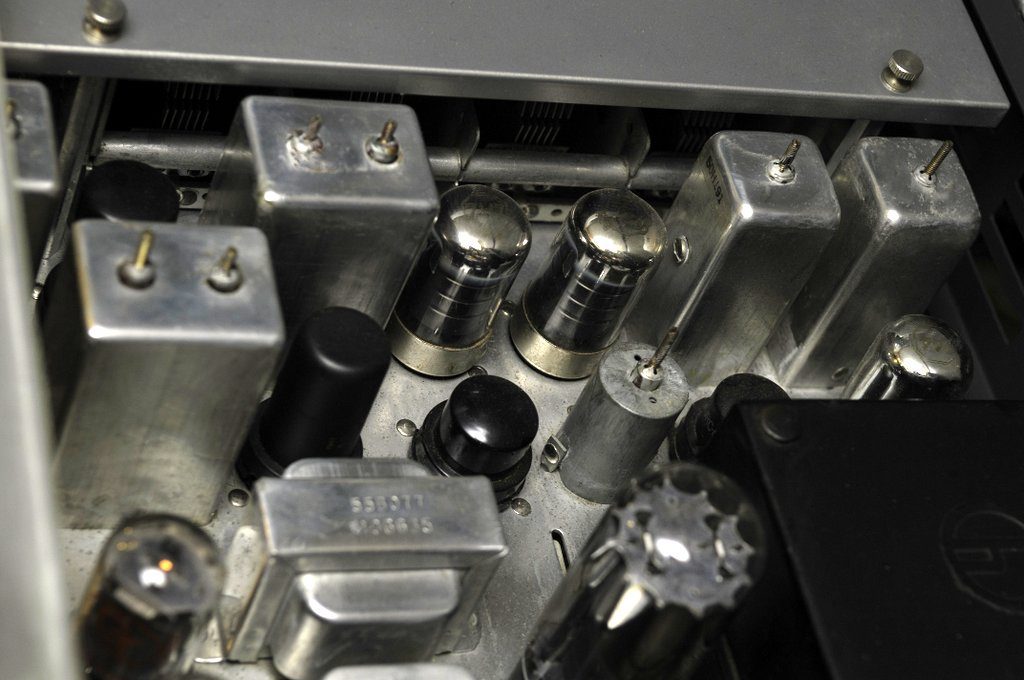 Years later, the focus became family, a child, and a house. The SX-42 and siblings came with me, but this time, in boxes. After having seen a WW2 vintage Hallicrafters S-20R at a consignment shop a couple of summers ago, I thought how cool it might be to have Dad’s radios electronically and cosmetically restored.
Years later, the focus became family, a child, and a house. The SX-42 and siblings came with me, but this time, in boxes. After having seen a WW2 vintage Hallicrafters S-20R at a consignment shop a couple of summers ago, I thought how cool it might be to have Dad’s radios electronically and cosmetically restored.
The S-38 and S40 were in a box in my damp basement. While intact, they had a considerable amount of rust. Luckily, I was able to find a gentleman with great electronic and mechanical skills. He brought the S38 back to life, working and looking beautiful. And is working still on the S-40. As for the SX-42, that was upstairs in a box in my son’s closet. Dry and somewhat preserved, but with some corrosion on the control panel. And sadly, that iconic lock knob that switches between main tuning and brandspread tuning, had been lost in the move. I had to find someone who could take this project on.
After an extensive search, I found my man. An engineer with his own business, who was moving into retirement, and shutting his business down. He had restored an SX-42 a few years back, with amazing results. I had to lure him out of retirement! Which I did after a few emails back and forth. And, he was within driving distance! First warning was “do not power the radio back up under any circumstance- you’ll fry the wafers on the bandswitch!” I resisted temptation, as I had read online that these were notorious for failure, usually to some original capacitors that leak over the decades.
After 13 months replacing every capacitor, virtually every resistor, and vacuum tube, the iconic radio was coming back to life, in a great way. The transmission and gears in the tuning was re-lubricated. During the restoration process, a date was found stamped on the chassis of October 25th, 1946. Could it be?
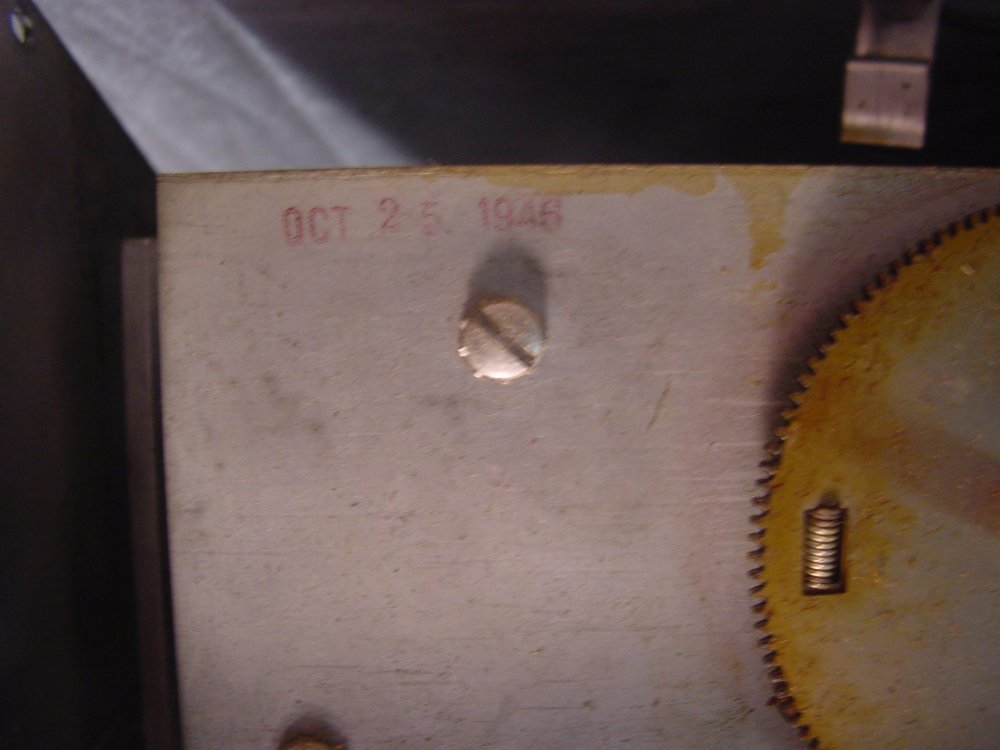 Hallicrafters had advertised in the Oct, 1946 issue of Radio News that “The first hundred are always the hardest to build.” This, coupled with the fact that none of the chassis circuit had been modified, lead my restorer to believe that my radio was one of the first 100 SX-42’s that Hallicrafters had built!
Hallicrafters had advertised in the Oct, 1946 issue of Radio News that “The first hundred are always the hardest to build.” This, coupled with the fact that none of the chassis circuit had been modified, lead my restorer to believe that my radio was one of the first 100 SX-42’s that Hallicrafters had built!
The front panel was stripped and treated, professionally painted and silkscreened. The cabinet and apron bead blasted, repainted, and clear coated. It came back home with me last month. A month after it turned 70.
As you can see here, the radio looks stunning. And, with all the Hallicrafters Service Bulletin mods implemented, sounds and performs better than I remember. Maybe more importantly, we were able to locate a replacement brake lock knob for the tuning shaft, even with the “Lock” decal and arrow showing to rotate it counterclockwise. It just would not have felt complete without that little knob- and, it works!
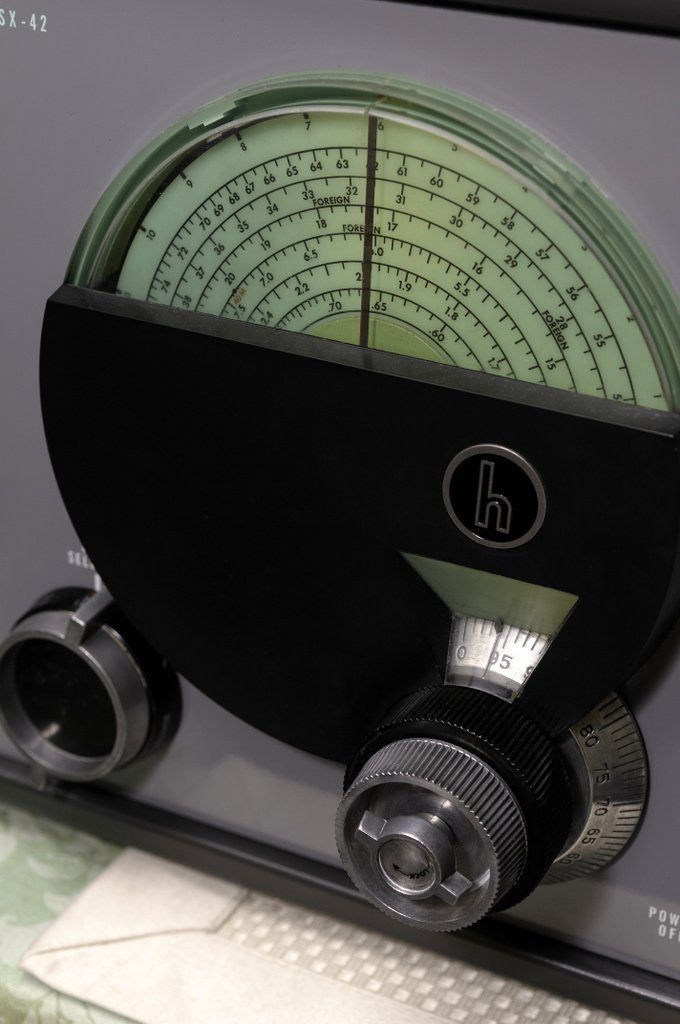 Engaging a set of what essentially are brake pads, you rotate it once to disengage the main tuning and engage the bandspread tuning. Again, and you’re back to main tuning.
Engaging a set of what essentially are brake pads, you rotate it once to disengage the main tuning and engage the bandspread tuning. Again, and you’re back to main tuning.
This radio will always remain a truly cherished family heirloom, and will be my son’s someday. Complete with the original owner’s manual, and Darth Vader-like R42 Reproducer (speaker).
Hopefully to live on for another 70-plus years, and hear more history along the way.
-Arthur Smith Worcester, MA
Wow–! Thank you so much for sharing your story with us, Arthur. No doubt, your SX-42 will certainly outlive all of us and will hopefully continue to be passed down through your family. What a wonderful story.

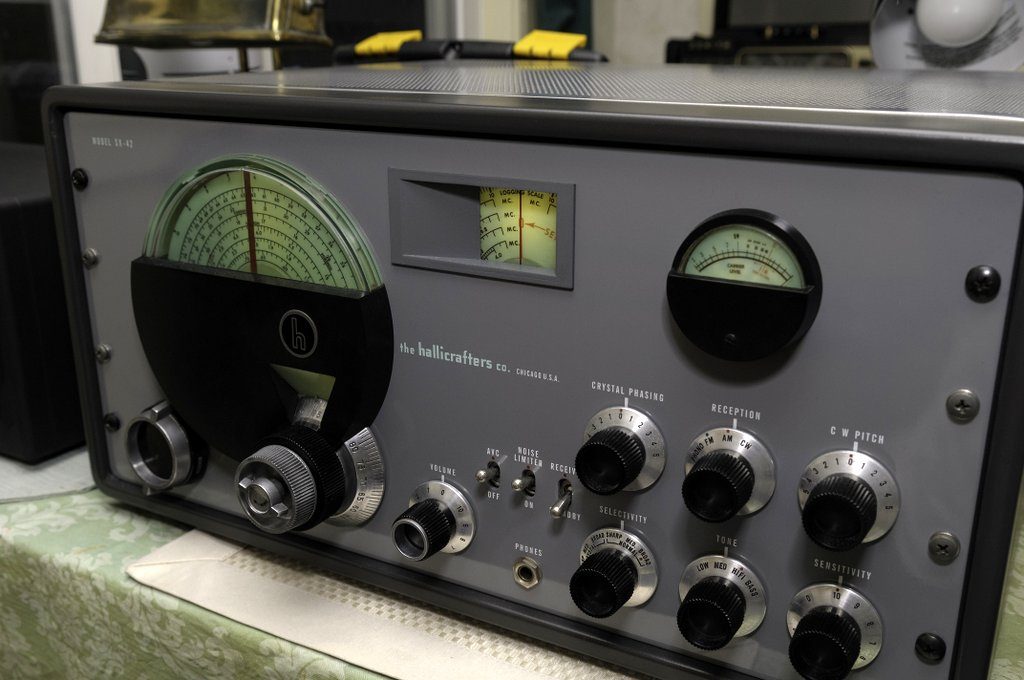
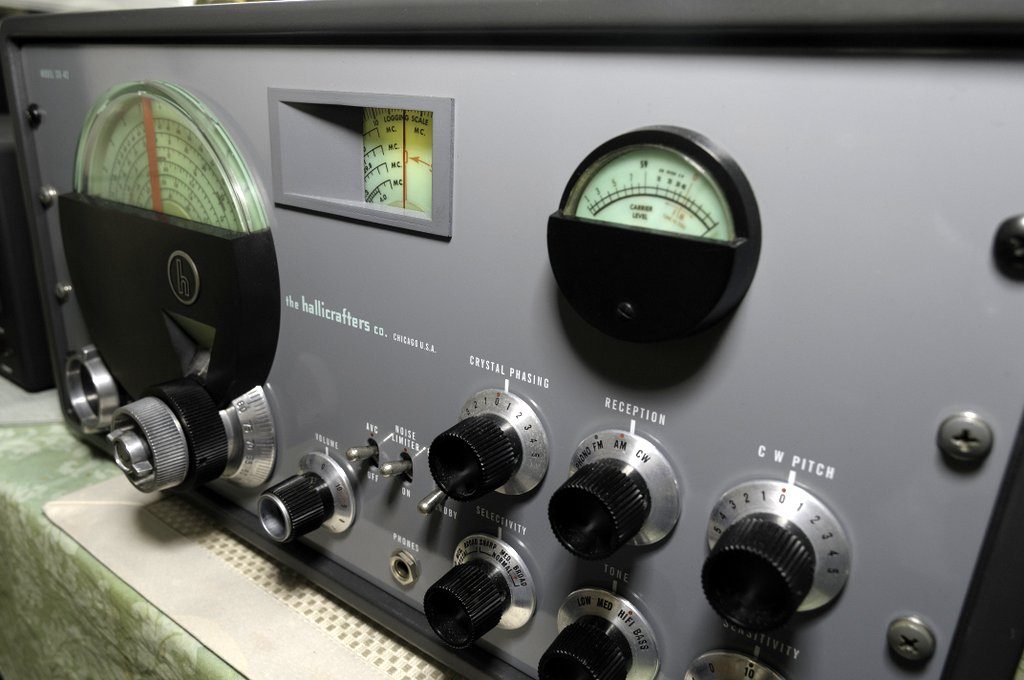
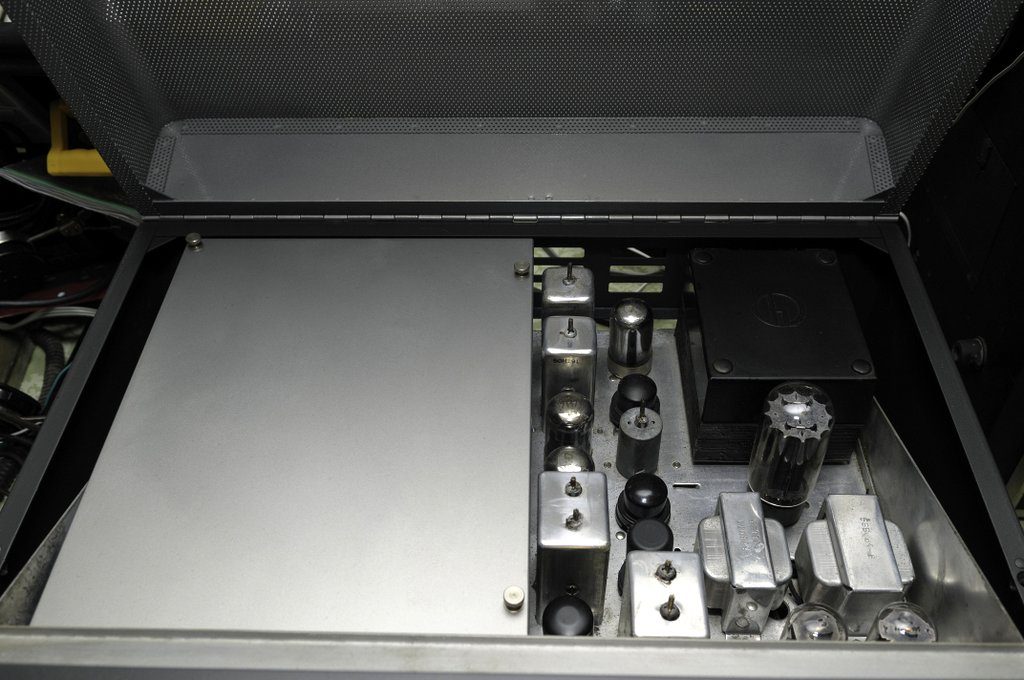
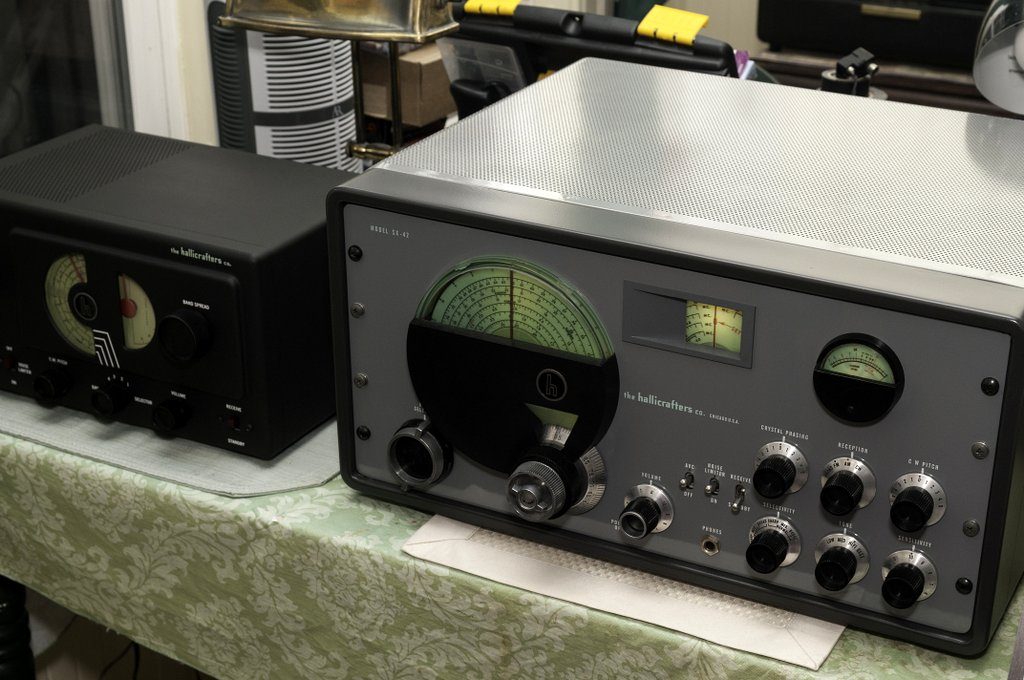
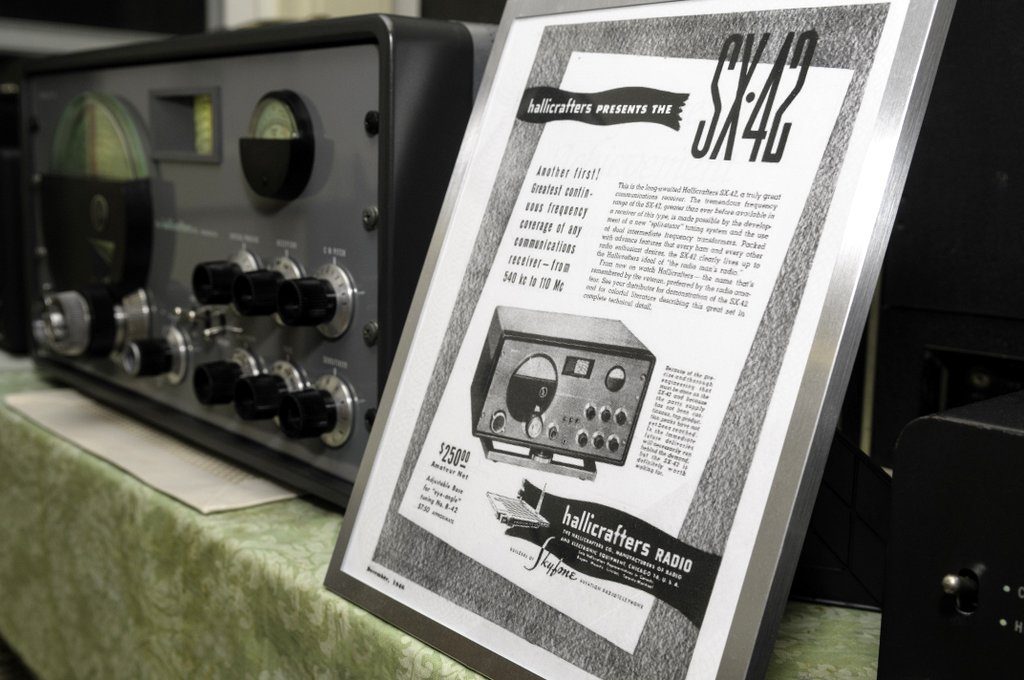
Interested in restoring the small lettering on my 1939 halicrafters S-19R. You mentioned silk screening. I need more information on this procedure. Would you know how this is done ?
Great story and I think it’s wonderful you have something your dad loved and will be passed down in the family, better yet that it is a rare first of production radio that is now restored for posterity. Thanks for sharing you story!
Welcome. The date matched up with Hallicrafters’ Radio News ad for the initial production run of 100 SX-42’s. In all the research I have done online, I have yet to find an older unit. Of course, all Hallicrafters records are now unobtanium. But this was the strongest clue I found.
When I was in Lakewood High School [1949-1952], several of my friends became hams.
One friend, W8FTD had the best receiver because his father had been 9DNI [before country prefixes were added].
His receiver was an SX43 which was the less expensive version of a SX42. According to my Allied Radio catalog at the time, a Hallicrafters SX42 receiver cost $100 more.
I still have my W8MIC ham license that I got in 1956.
And I’ve bought and sold dozens of short-wave receivers over my 40-years as a hamfest seller. – Lee
Yes, an SX42 was a pretty expensive radio back in the day. So proud to be its second owner, after my father.
I bought and sold several SX42 receivers at hamfests over the years. And I still have one in my receiver collection. – W8MIC Lee
Lee- it’s such a fun radio, as I’m sure you know. Enjoy! Arthur
To all those who wanted to see a detailed “step by step” restoration blog, well, that’s not why I hired who I did. I hired a skilled craftsman who clearly does fine work- he is retired, and based on his previous restoration of his own SX-42, I asked him to do this job. I didn’t hire him to take photos, write a deep “in the weeds” detail. I wanted to share my love of, and the human story of, this radio.
Awesome story and pics! Gorgeous!
Absolutely a thing of beauty. I am so proud of the ham tradition of preserving these fine old radios for future generations. And this restoration job was literally a work of art. You are fortunate to have found this gentleman. I agree, it would be great to see a review of his methods.
Tim WA5MD
I enjoyed this post very much. The SX-42 was certainly groundbreaking for inclusion of both pre-war and post-war FM broadcast bands. The design is stunning. I am also fortunate to have an heirloom communications receiver. I have my Dad’s WWII Hammarlund RBG-2 among the boat anchor collection. It is a militarized HQ-120.
Thank you to you, and all who are enjoying this piece. Truly in love with this historic piece of Americana.
I just wanted to add that I am envious of you and happy, all at the same time! What a handsome rig and as someone who loves things like this, I am pleased to know it turned out so well! I am constantly stopping by pawn shops, flea markets, garage sales, etc. hoping to find something just like this!
Again, well done, Arthur!
What a great piece telling the family history of this beautiful radio. Thanks so much for posting.
There are youtubes on restoration of old radios similar to this, most focus on the re-capping and rf alignment issues. I would like to see more on the physical part of the process, Where the innards re-plated? and the paint job how are the original lettering above the knobs ant the logo preserved? Sometimes it is just as interesting seeing the grand masters practicing their radio craft as it is the end result of their efforts.
It was professionally restored by a gentleman who had previously restored his own SX42. The control panel was stripped, refinished, painted, and silk screened. All new tubes, caps, and resistors. The chassis is all original. I have also seen many videos as you described. Caps and a deep dive into alignment was not the purpose in wanting to share this story. My love of the radio, and how it became a family heirloom, was.
Considering the fact that this could possibly been the first unit of it’s model by itself, a difficult effort to find the right restorer for something more than a collectible but a historical treasure. Other than the date in the picture, was there a serial number?
That’s a beautifully restored rig and a great part of radio history to hand down.
Great story too.
Thanks- that was precisely the purpose of my piece.
Amazingly beautiful! I am surprised how clean everything is, inside and out! Happy listening.
Wow! Simply beautiful, and a great family history! Thanks for sharing!
What a gorgeous rig! I gotta say, I am impressed! I absolutely love the older receivers! Thank you so much for sharing your story!